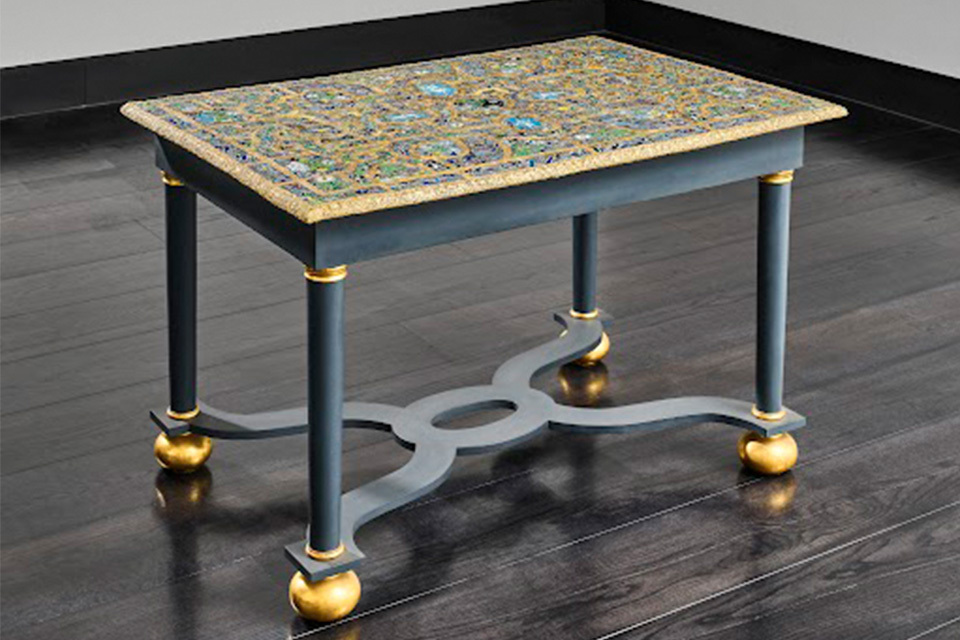World
Exquisite table top once owned by Louis XIV at risk of leaving the UK

- The table top is valued at more than £7 million
- The export bar will allow time for a UK gallery or institution to acquire the table top for the nation
An export bar has been placed on a richly adorned table top once owned by Louis XIV, King of France.
The table top, valued at £7,500,000 (plus VAT of £300,000), is at risk of leaving the UK unless a domestic buyer can be found to save it for the nation.
The table top is made of 111 panels of masterfully worked glass, using a mixture of filigree, or coloured canes of glass fused together, and pictorial panels made using the lampwork and casting technique. The glass panels are framed by a structure of gilded metalwork.
The pictorial panels depict a scene from the mythological story of the Judgement of Paris, as well as classical gods and goddesses, alongside scenes of hunting, flora and fauna.
The table top was listed in the inventory of furniture belonging to Louis XIV and has been attributed to one the most prominent and inventive glassmakers in France in the second half of the 17th century, Bernard Perrot of Orléans.
The decision to place an export bar on the item follows the advice of the Reviewing Committee on the Export of Works of Art and Objects of Cultural Interest. The committee made its recommendation on the basis that the table top met the second and third Waverley criteria for its outstanding aesthetic importance, and its outstanding significance to the study of the work of Bernard Perrot and other émigré glassmakers working in France in the 17th century.
It was also deemed to be of outstanding significance to the study of interiors in France, decorative art design, and the history of British industrialist collecting.
Committee Member Helen Jacobsen said:
Perrot’s stunning table top is unprecedented in the history of glass and of 17th-century decorative art. Its technical mastery and striking design have ensured its place as a masterpiece since it was first recorded in the collections of Louis XIV in 1681 and in its sophistication and artistic ambition the table is unsurpassed.
It is of enormous importance as a documentary milestone, both in Perrot’s career and in the technical development of 17th-century glass-making, and the opportunities for future research into materials and techniques, as well as design, interiors and collecting more generally, are enormous. The impact of the table top as an aesthetic object cannot be overstated and I really hope that it can find a home in a UK museum where it can be admired and enjoyed by the widest possible audience.
The decision on the export licence application for the table top will be deferred for a period ending on 18 October 2024 inclusive. At the end of the first deferral period owners will have a consideration period of 15 Business Days to consider any offer(s) to purchase the table top at the recommended price of £7,500,000 (plus VAT of £300,000 which can be reclaimed by an eligible institution). The second deferral period will commence following the signing of an Option Agreement and will last for six months.
Notes to editors:
- Organisations or individuals interested in purchasing the carving should contact the RCEWA on 02072680534 or rcewa@artscouncil.org.uk .
- Details of the object are as follows: Table top made of panels of millefiori, lampworked and cast glass set onto a copper base with repousse gilt-brass surrounds. Attributed to Bernard Perrot (1640-1709) made 1668-1681. 117 x 81 cm.
- Provenance: In the collection of Louis XIV by 1681
- Sold by the Garde Meuble, 4 August 1752, purchased by ‘Sr Boucher’
- Sold ‘the Property of Sir Adrian Beecham, Bt., removed from Clopton House, Stratford-on-Avon’, Christie’s, London, 25 June 1975, lot 91
- Sold Sotheby’s, London, 24 November 1988, lot 4 (anonymous sale)
- The Reviewing Committee on the Export of Works of Art and Objects of CulturalInterest is an independent body, serviced by Arts Council England (ACE), which advises the Secretary of State for Culture, Media and Sport on whether a cultural object, intended for export, is of national importance under specified criteria.










